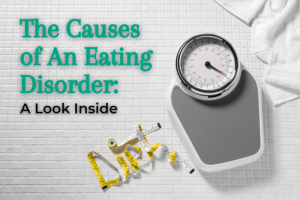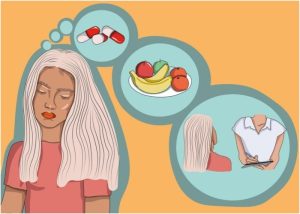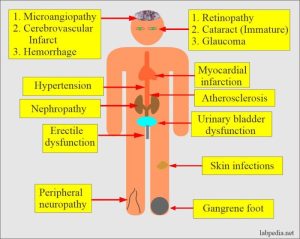Step right up and explore the fascinating world of eating disorders! From anorexia nervosa to binge eating disorder, get ready for an enlightening journey into the complexities of these conditions.
Let’s dive deep into the different types of eating disorders, their symptoms, causes, and impact on mental health.
Types of Eating Disorders
Eating disorders are serious mental health conditions that can have severe consequences on physical health. There are several types of eating disorders, each with its own set of symptoms and potential causes.
Anorexia Nervosa
Anorexia nervosa is characterized by an intense fear of gaining weight and a distorted body image. Individuals with anorexia often severely restrict their food intake, leading to significantly low body weight. Some common symptoms of anorexia nervosa include:
- Extreme weight loss
- Preoccupation with food, calories, and dieting
- Avoiding meals or making excuses not to eat
- Excessive exercise
- Denial of hunger
Bulimia Nervosa
Bulimia nervosa involves cycles of binge eating followed by purging behaviors, such as self-induced vomiting or misuse of laxatives. This eating disorder is often driven by a desire to control weight and shape. Potential causes of bulimia nervosa may include:
- Poor body image
- Low self-esteem
- History of dieting or weight concerns
- Stressful life events
- Genetic predisposition
Binge Eating Disorder
Binge eating disorder is characterized by recurrent episodes of consuming large amounts of food in a short period while feeling a lack of control over eating. Unlike bulimia, individuals with binge eating disorder do not engage in purging behaviors. This disorder can have a significant impact on mental health, leading to feelings of guilt, shame, and distress. It may also contribute to other health issues, such as obesity and heart disease.
Cosmetic Surgery
Cosmetic surgery is a branch of plastic surgery that focuses on enhancing a person’s appearance through surgical and medical techniques. It has become increasingly popular in recent years, with advancements in technology and techniques making procedures safer and more accessible than ever before.Cosmetic surgery can have a significant impact on an individual’s self-esteem and body image. Many people choose to undergo cosmetic procedures to improve their confidence and feel more comfortable in their own skin.
However, it is essential to understand the risks and benefits associated with cosmetic surgery before making a decision.
Common Types of Cosmetic Surgeries
- Rhinoplasty: A nose job to reshape or resize the nose.
- Breast Augmentation: Enhancing the size and shape of breasts through implants or fat transfer.
- Liposuction: Removing excess fat deposits from various areas of the body.
- Facelift: Tightening and lifting the skin of the face to reduce signs of aging.
- Botox Injections: Smoothing out wrinkles and fine lines on the face.
Risks and Benefits of Cosmetic Surgery
- Risks: Possible complications such as infections, scarring, and adverse reactions to anesthesia.
- Benefits: Improved self-confidence, enhanced physical appearance, and correction of physical abnormalities.
Impact on Self-Esteem and Body Image
Cosmetic surgery can have a profound impact on an individual’s self-esteem and body image. For many people, undergoing a cosmetic procedure can lead to increased confidence and a more positive self-image. However, it is crucial to have realistic expectations and understand that cosmetic surgery is not a quick fix for underlying psychological issues.
Foot Health

Maintaining foot health is crucial for overall well-being, as our feet support our entire body weight and allow us to move around. Neglecting foot health can lead to various issues that can affect our daily activities and quality of life.Proper footwear plays a significant role in preventing common foot problems such as plantar fasciitis and bunions. Ill-fitting shoes, high heels, or shoes without proper support can put strain on our feet, leading to conditions like plantar fasciitis, which causes heel pain and discomfort.
Bunions, on the other hand, are bony bumps that develop at the base of the big toe, often aggravated by narrow or tight shoes.
Common Foot Problems
- Plantar Fasciitis: This condition causes pain in the heel or bottom of the foot, usually worse in the morning or after long periods of standing.
- Bunions: Characterized by a bony bump at the base of the big toe, bunions can be painful and worsen over time if not addressed.
Importance of Proper Footwear
- Choose shoes that provide adequate support, cushioning, and room for your toes to move comfortably.
- Avoid high heels or shoes with narrow toe boxes, as they can contribute to foot problems like bunions and hammertoes.
- Regularly check the fit of your shoes and replace them when they show signs of wear to maintain foot health.
Connection Between Foot Health and Overall Well-being
- Foot pain or discomfort can affect our mobility and quality of life, leading to limitations in daily activities and exercise.
- Proper foot care can prevent issues that may cause pain or discomfort, promoting an active and healthy lifestyle.
- Regularly inspecting your feet, wearing proper footwear, and seeking medical attention for any foot problems can help maintain overall well-being.
Heart Disease
Heart disease is a leading cause of death worldwide, with risk factors such as high cholesterol and hypertension contributing to its prevalence. Lifestyle changes and dietary habits play a crucial role in preventing heart disease and maintaining overall heart health.
Risk Factors for Heart Disease
- High Cholesterol: Elevated levels of cholesterol in the blood can lead to the buildup of plaques in the arteries, increasing the risk of heart disease.
- Hypertension: High blood pressure puts added strain on the heart and blood vessels, increasing the risk of heart attacks and strokes.
Lifestyle Changes for Heart Health
- Regular Exercise: Engaging in physical activity can help lower blood pressure, improve cholesterol levels, and reduce the risk of heart disease.
- Healthy Diet: Consuming a diet rich in fruits, vegetables, whole grains, and lean proteins can help maintain heart health and reduce the risk of cardiovascular issues.
- Quitting Smoking: Smoking is a major risk factor for heart disease, and quitting can significantly improve heart health and overall well-being.
Link Between Heart Health and Diet
Eating a balanced diet that is low in saturated fats, cholesterol, and sodium can help prevent the development of heart disease. Incorporating foods rich in omega-3 fatty acids, such as fish, nuts, and seeds, can also promote heart health by reducing inflammation and supporting overall cardiovascular function.
Health Diabetes
Diabetes is a chronic condition that affects how your body turns food into energy. There are three main types of diabetes: Type 1, Type 2, and gestational diabetes.
Types of Diabetes
- Type 1 Diabetes: This type of diabetes occurs when the immune system mistakenly attacks and destroys insulin-producing cells in the pancreas. People with Type 1 diabetes need to take insulin injections to survive.
- Type 2 Diabetes: In Type 2 diabetes, the body either resists the effects of insulin or doesn’t produce enough insulin to maintain normal glucose levels. It is the most common form of diabetes and is often linked to lifestyle factors like obesity and lack of physical activity.
- Gestational Diabetes: Gestational diabetes develops during pregnancy and usually goes away after giving birth. However, women who have had gestational diabetes have a higher risk of developing Type 2 diabetes later in life.
Symptoms and Complications
- Common symptoms of diabetes include frequent urination, excessive thirst, unexplained weight loss, fatigue, and blurred vision.
- Complications of diabetes can include heart disease, stroke, nerve damage, kidney disease, and vision problems.
Managing Diabetes with Diet and Exercise
Proper management of diabetes involves maintaining a healthy diet and staying physically active. A balanced diet rich in fruits, vegetables, whole grains, lean protein, and healthy fats can help control blood sugar levels. Regular exercise, such as walking, swimming, or cycling, can also improve insulin sensitivity and help manage weight.
Eating Disorders
Eating disorders are serious mental health conditions that can have severe physical consequences if left untreated. They are characterized by disturbances in eating habits and behaviors, often leading to harmful patterns that impact a person’s overall well-being.Anorexia Nervosa:Anorexia nervosa is an eating disorder characterized by an intense fear of gaining weight, a distorted body image, and extreme efforts to control food intake.
Individuals with anorexia often severely restrict their food intake, leading to significant weight loss and malnutrition. This disorder can have life-threatening consequences if not addressed promptly.Bulimia Nervosa:Bulimia nervosa involves recurrent episodes of binge eating followed by compensatory behaviors such as vomiting, excessive exercise, or the misuse of laxatives or diuretics. Individuals with bulimia often feel a lack of control during these binge episodes and may engage in these harmful behaviors to counteract feelings of guilt or shame.
It can also lead to severe medical complications if not treated.Binge Eating Disorder:Binge eating disorder is characterized by recurrent episodes of consuming large quantities of food in a short period, often feeling a loss of control during these episodes. Unlike bulimia, individuals with binge eating disorder do not engage in compensatory behaviors. This disorder can lead to obesity, high blood pressure, and other health issues if not addressed.Psychological Factors:The development of eating disorders is influenced by a combination of genetic, biological, environmental, and psychological factors.
Factors such as low self-esteem, perfectionism, trauma, and societal pressures can contribute to the onset of these disorders. It is crucial to address these underlying psychological issues in treatment.Treatment Options:Treatment for eating disorders typically involves a combination of psychotherapy, nutritional counseling, and medical monitoring. Cognitive-behavioral therapy (CBT) and dialectical behavior therapy (DBT) are commonly used approaches to help individuals challenge negative thoughts and behaviors related to food and body image.
In severe cases, hospitalization or residential treatment may be necessary to stabilize medical complications and provide intensive support.Remember, early intervention and comprehensive treatment are essential for recovery from eating disorders. If you or someone you know is struggling with disordered eating behaviors, seek help from a qualified healthcare professional.
Epilogue

As we wrap up our discussion on eating disorders, remember that understanding and awareness are key in addressing these issues. Whether it’s anorexia, bulimia, or binge eating, seeking help and support is always a step in the right direction.
FAQ Explained
Can men also develop eating disorders?
Yes, eating disorders can affect individuals of any gender.
Are eating disorders solely about food?
No, eating disorders often have underlying emotional and psychological factors.
Is recovery from an eating disorder possible?
Absolutely, with the right support and treatment, many individuals can recover from eating disorders.




